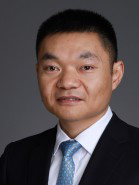

Position:Chair of Pharmacy
Department:Pharmacy
Medical School:Zhejiang University School of Medicine, China
Academic Rank:Chief Pharmacist
The role and mechanism of histone deacetylation in central nervous system diseases.
National Excellent Clinical Pharmacist, Clinical Pharmacy Branch, Chinese Medical Association, 2016
Zhejiang Provincial Pharmaceutical Science and technology award, First Prize, 2015
The 18th SERVIER Young Pharmacological Worker, Chinese Pharmacological Society, 2014
Vice Chairman, Clinical Rational Drug Use Committee, China Medical Education Association
Member, Neuropsychopharmacology Committee, Chinese Society of Pharmacology
Secretary General, New Drug Development and Evaluation Branch, Chinese Stroke Society
Vice President, Zhejiang Pharmacology Society
Vice Chairman, Therapeutic Drug Monitoring and Research Committee, Zhejiang Pharmacology Society
Member, Clinical Pharmacy Committee, Zhejiang Medical Association
Executive Editorial Board Member, Chinese Journal of Modern Applied Pharmacy
Human genome wide association analysis (GWAS) showed that histone deacetylase 9 (HDAC9) was closely related to stroke. Our previous study also found that HDAC9 expression on neurons increased after cerebral ischemia in mice, and specific knockout of HDAC9 (CKO) on excitatory neurons in mice could protect neuron apoptosis induced by cerebral ischemia-reperfusion (I / P), while reversal of HDAC9 in CKO mice by adeno-associated virus infection could protect brain injury induced by I / P. Further study showed that PKG II expression in cerebral cortex of CKO mice increased after cerebral ischemia, while PKG II decreased significantly after adeno-associated virus refilling HDAC9, suggesting that HDAC9 may play a role through PKG II, but the specific mechanism is unknown. We analyzed that mef-2 may be a transcription factor binding to PKG II transcription initiation region through database, while HDAC9 can bind to mef-2 and inhibit downstream gene expression. Therefore, we propose the hypothesis that after cerebral ischemia reperfusion, the expression of HDAC9 in excitatory neurons increases, which can inhibit the expression of PKG II through mef-2, leading to neuron apoptosis.
Xu H, Zou J, Ye X, Han J, Gao L, Luo S, Wang J, Huang C, Yan X, Dai H*. Impacts of Clinical Pharmacist Intervention on the Secondary Prevention of Coronary Heart Disease: A Randomized Controlled Clinical Study. Front Pharmacol. 2019 Oct 8;10:1112.
Hu Y, He W, Yao D, Dai H*. Intrathecal or intraventricular antimicrobial therapy for post-neurosurgical intracranial infection due to multidrug-resistant and extensively drug-resistant Gram-negative bacteria: A systematic review and meta-analysis. Int J Antimicrob Agents. 2019 Nov;54(5):556-561.
Li W, Chen Z, Yuan J, Yu Z, Cheng C, Zhao Q, Huang L, Hajjar KA, Chen Z, Lo EH, Dai H*, Wang X*. Annexin A2 is a Robo4 ligand that modulates ARF6 activation-associated cerebral trans-endothelial permeability. J Cereb Blood Flow Metab. 2019 Oct;39(10):2048-2060.
Li W, Chen Z, Chin I, Chen Z, Dai H*. The role of VE-cadherin in blood-brain barrier integrity under central nervous system pathological conditions. Curr Neuropharmacol. 2018;16(9):1375-1384.
Yu L, Lu Z, Burchell S, Nowrangi D, Manaenko A, Li X, Xu Y, Xu N, Tang J, Dai H*, Zhang JH*. Adropin preserves the blood-brain barrier through a Notch1/Hes1 pathway after intracerebral hemorrhage in mice. J Neurochem. 2017 Dec;143(6):750-760.
Xu H, Ping Y, Lin H, He P, Li W, Dai H*. Antiplatelet Strategies and Outcomes in Patients with Noncardioembolic Ischemic Stroke from a Real-World Study with a Five-Year Follow-Up. Transl Stroke Res. 2017 Jun;8(3):228-233.
Xu H, Cai S, Dai H*. Characteristics of Infective Endocarditis in a Tertiary Hospital in East China. PLoS One. 2016 Nov 18;11(11):e0166764.
Li W, Chen Z, Yan M, He P, Chen Z, Dai H*. The protective role of Isorhamnetin on human brain microvascular endothelial cells from cytotoxicity induced by methylglyoxal and oxygen glucose deprivation. J Neurochem. 2016 Feb;136(3):651-9.
Fang L, Li X, Zhong Y, Yu J, Yu L, Dai H*, Yan M*. Autophagy protects Human Brain Microvascular Endothelial Cells against Methylglyoxal-induced Injuries: in parallel with Cerebral Ischemic Model in Diabetic Rats. J Neurochem. 2015 135(2):431-40.
Hu Y, Li L, Li W, Xu H, He P, Yan X, Dai H*. Combination antibiotic therapy versus monotherapy for Pseudomonas aeruginosa bacteraemia: A meta-analysis of retrospective and prospective studies. Int J Antimicrob Agents. 2013.42: 492–496.
Li W, Xu H, Hu Y, He P, Ni Z, Xu H, Zhang Z, Dai H*. Edaravone Protected Human Brain Microvascular Endothelial Cells from Methylglyoxal-Induced Injury by Inhibiting AGEs/RAGE/Oxidative Stress. PLoS ONE. 2013. 8(9): e76025.
Dai H*, Yu Z, Fan X, Liu N, Yan M, Chen Z, Lo EH, Hajjar KA, Wang X*. Dysfunction of annexin A2 contributes to hyperglycemia-induced loss of human endothelial cell surface fibrinolytic activity. Thromb Haemost. 2013 Mar 21;109(6): 1070-8.
Yan M, Dai H, Ding T, Dai A, Zhang F, Yu L, Chen G, Chen Z. Effects of dexmedetomidine on the release of glial cell line-derived neurotrophic factor from rat astrocyte cells. Neurochem Int. 2011; 58(5):549-57.
Fan YY#, Hu WW#, Dai HB#, Zhang JX, Zhang LY, He P, Shen Y, Ohtsu H, Wei EQ, Chen Z. Activation of the central histaminergic system is involved in hypoxia-induced stroke tolerance in adult mice. J Cereb Blood Flow Metab. 2011;31(1):305-14.
Dai H, Zhang Z, Zhu Y, Shen Y, Hu W, Huang Y, Luo J, Timmerman H, Leurs R, Chen Z. Histamine protects against NMDA-induced necrosis in cultured cortical neurons through H2 receptor/cyclic AMP/protein kinase A and H3 receptor/GABA release pathways. J Neurochem 2006;96:1390-400.
The role and mechanism of annexin A2 in the dissociation of VE cadherin complex after cerebral ischemia. Funding Source: National Natural Science Founation of China (81773700).